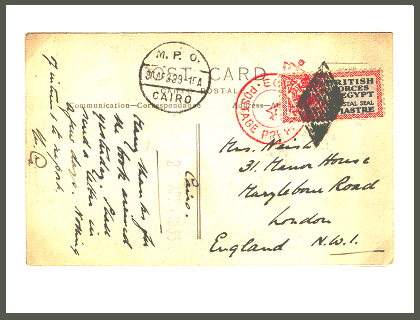|
In 1932 Egypt increased its internal postal rate from 10 millièmes (approximately 2 ½ d) to 15 millièmes and to make life easier for British troops in Egypt
an agreement was reached between the War Office and the Egyptian authorities for a concessionary rate. It was agreed that Britain would pay the Egyptian
Government £10,000 in the first year and £6,000 in the second, to compensate for the loss of revenue caused by postal concession. Introduced on November 1, 1932,
it applied only to letters to Britain and the Irish Free State. Circular handstamps - comprising double concentric circles of outer diameter 27 ½ mm, topped
with a crown with the words Egypt Postage Paid and a number in the centre - were supplied by the Egyptian authorities and indicated that postage had been paid
on a letter. To defray some of the cost, "seals" were sold over the counter at the NAAFI canteens to members of the Forces only. It was agreed that this seal
was to be stuck on the back of the envelope, so as to avoid confusion among the Egyptian postal staff, and it was cancelled by a retta handstamp. Any letters
bearing Forces "seals" posted in civilian letter boxes were treated as unpaid, and taxed.
|

|
| The original "postal seal" of November 1, 1932, was replaced in august 1933 with an almost precisely similar "letter seal". |

|
|
At Christmas and New Year special "Xmas seals" were produced from 1932 through to 1935. They were intended for use only on unsealed envelopes. |

|
|
A new design was issued on January 1, 1934, with the words "LETTER STAMP" now incorporated. As before, they were to be stuck on the back of the envelope.
For the 1935 Jubilee a special seal was issued on May 6. Because of a shortage of Xmas seals in 1935 a provisional surcharge was issued on December 16.
|
 |
The franking power was in the crown handstamp placed on the face of the cover. This was normally in red but is also found in blue. |
 |

|
|
On March 1, 1936, the seals were replaced by "Army Post" stamps. Similar conditions applied, other than that they were to be stuck on the face as normal stamps.
The 10m value was intended for surface postage and the 3m for unsealed Christmas and New Year letters and cards.
|
 Needless to say, letters bearing the Army seal and stamps were not always used as intended.
Needless to say, letters bearing the Army seal and stamps were not always used as intended.
 
|

